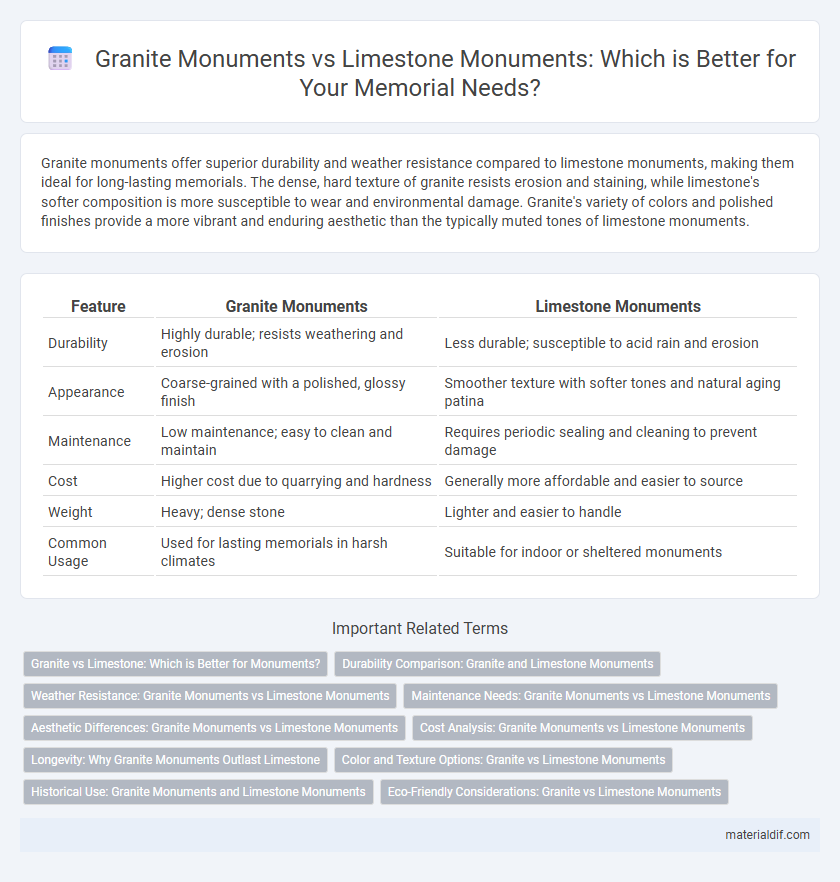Granite monuments offer superior durability and weather resistance compared to limestone monuments, making them ideal for long-lasting memorials. The dense, hard texture of granite resists erosion and staining, while limestone's softer composition is more susceptible to wear and environmental damage. Granite's variety of colors and polished finishes provide a more vibrant and enduring aesthetic than the typically muted tones of limestone monuments.
Table of Comparison
| Feature | Granite Monuments | Limestone Monuments |
|---|---|---|
| Durability | Highly durable; resists weathering and erosion | Less durable; susceptible to acid rain and erosion |
| Appearance | Coarse-grained with a polished, glossy finish | Smoother texture with softer tones and natural aging patina |
| Maintenance | Low maintenance; easy to clean and maintain | Requires periodic sealing and cleaning to prevent damage |
| Cost | Higher cost due to quarrying and hardness | Generally more affordable and easier to source |
| Weight | Heavy; dense stone | Lighter and easier to handle |
| Common Usage | Used for lasting memorials in harsh climates | Suitable for indoor or sheltered monuments |
Granite vs Limestone: Which is Better for Monuments?
Granite offers superior durability and weather resistance compared to limestone, making it the preferred choice for long-lasting monuments exposed to outdoor elements. The dense crystalline structure of granite ensures minimal erosion and color fading over time, whereas limestone, being softer and more porous, tends to wear down and stain more easily. These properties make granite better suited for monuments requiring strength, longevity, and maintenance of aesthetic appeal.
Durability Comparison: Granite and Limestone Monuments
Granite monuments exhibit superior durability compared to limestone monuments due to granite's dense, coarse-grained composition, which resists weathering and erosion more effectively. Limestone, being a softer sedimentary rock primarily composed of calcite, is more susceptible to acid rain and physical wear, leading to faster degradation in outdoor environments. The longevity of granite monuments makes them a preferred choice for memorials and monuments requiring long-term structural integrity and minimal maintenance.
Weather Resistance: Granite Monuments vs Limestone Monuments
Granite monuments exhibit superior weather resistance compared to limestone monuments due to their dense, crystalline structure, which withstands erosion and acid rain more effectively. Limestone, a softer sedimentary rock, tends to erode faster under harsh weather conditions, leading to surface degradation and loss of intricate details over time. This durability makes granite a preferred choice for outdoor monuments requiring long-lasting preservation against environmental elements.
Maintenance Needs: Granite Monuments vs Limestone Monuments
Granite monuments require significantly less maintenance than limestone monuments due to granite's dense, non-porous structure, which resists weathering, staining, and erosion. Limestone, being softer and more porous, demands frequent cleaning and sealing to prevent surface degradation caused by acid rain and environmental pollutants. Choosing granite reduces long-term upkeep costs and preserves inscriptions and details more effectively over time.
Aesthetic Differences: Granite Monuments vs Limestone Monuments
Granite monuments exhibit a rich variety of colors and intricate grain patterns, providing a polished and durable surface that resists weathering, preserving inscriptions and designs over time. Limestone monuments showcase softer tones with a matte finish, offering a more traditional and natural look but are prone to erosion and discoloration due to their porous composition. The choice between granite and limestone impacts the longevity and visual appeal of monuments, with granite favoring bold, lasting aesthetics and limestone delivering subtle, aged beauty.
Cost Analysis: Granite Monuments vs Limestone Monuments
Granite monuments generally have a higher upfront cost compared to limestone monuments due to the durability and density of granite, which requires more labor-intensive cutting and polishing. Limestone monuments are typically more affordable initially but may incur higher long-term maintenance costs because limestone is more porous and prone to weathering and erosion. When considering total cost of ownership, granite monuments offer better value through enhanced longevity and reduced restoration expenses.
Longevity: Why Granite Monuments Outlast Limestone
Granite monuments exhibit superior longevity compared to limestone due to their dense, hard mineral composition, primarily quartz and feldspar, which resists weathering and erosion. Unlike limestone, which is calcium carbonate-based and susceptible to acid rain and surface degradation, granite maintains structural integrity and aesthetic appeal for centuries. This durability makes granite the preferred choice for long-lasting memorials and monuments in various climates.
Color and Texture Options: Granite vs Limestone Monuments
Granite monuments offer a wide range of color options, including shades of black, gray, pink, and red, with a polished, speckled texture that enhances durability and visual appeal. Limestone monuments typically present softer, earthy tones such as beige, cream, and light gray, featuring a more uniform, matte texture that conveys a classic, timeless look. The granularity and polish of granite provide greater resistance to weathering, maintaining color vibrancy longer than the porous, softer surface of limestone.
Historical Use: Granite Monuments and Limestone Monuments
Granite monuments have been favored historically for their exceptional durability and resistance to weathering, which is why many ancient structures such as Egyptian pyramids and Roman temples feature granite prominently. Limestone monuments, widely used in classical architecture, offer ease of carving and have been preferred for intricate decorative details in churches and memorials throughout European history. The lasting visual appeal of granite contrasts with the more porous, susceptible nature of limestone, influencing its role in monuments that require both structural strength and artistic expression.
Eco-Friendly Considerations: Granite vs Limestone Monuments
Granite monuments offer superior durability and weather resistance compared to limestone, reducing the need for frequent restoration and associated environmental impact. Limestone extraction and processing tend to produce higher carbon emissions due to softer stone requiring more intensive quarrying and finishing techniques. Using granite monuments supports long-term sustainability through reduced maintenance and lower lifecycle environmental footprint, making them a more eco-friendly choice in memorial construction.
Granite Monuments vs Limestone Monuments Infographic

 materialdif.com
materialdif.com